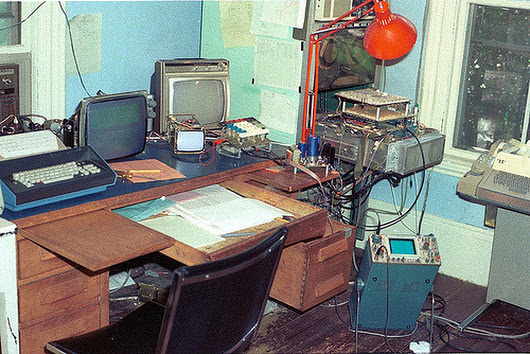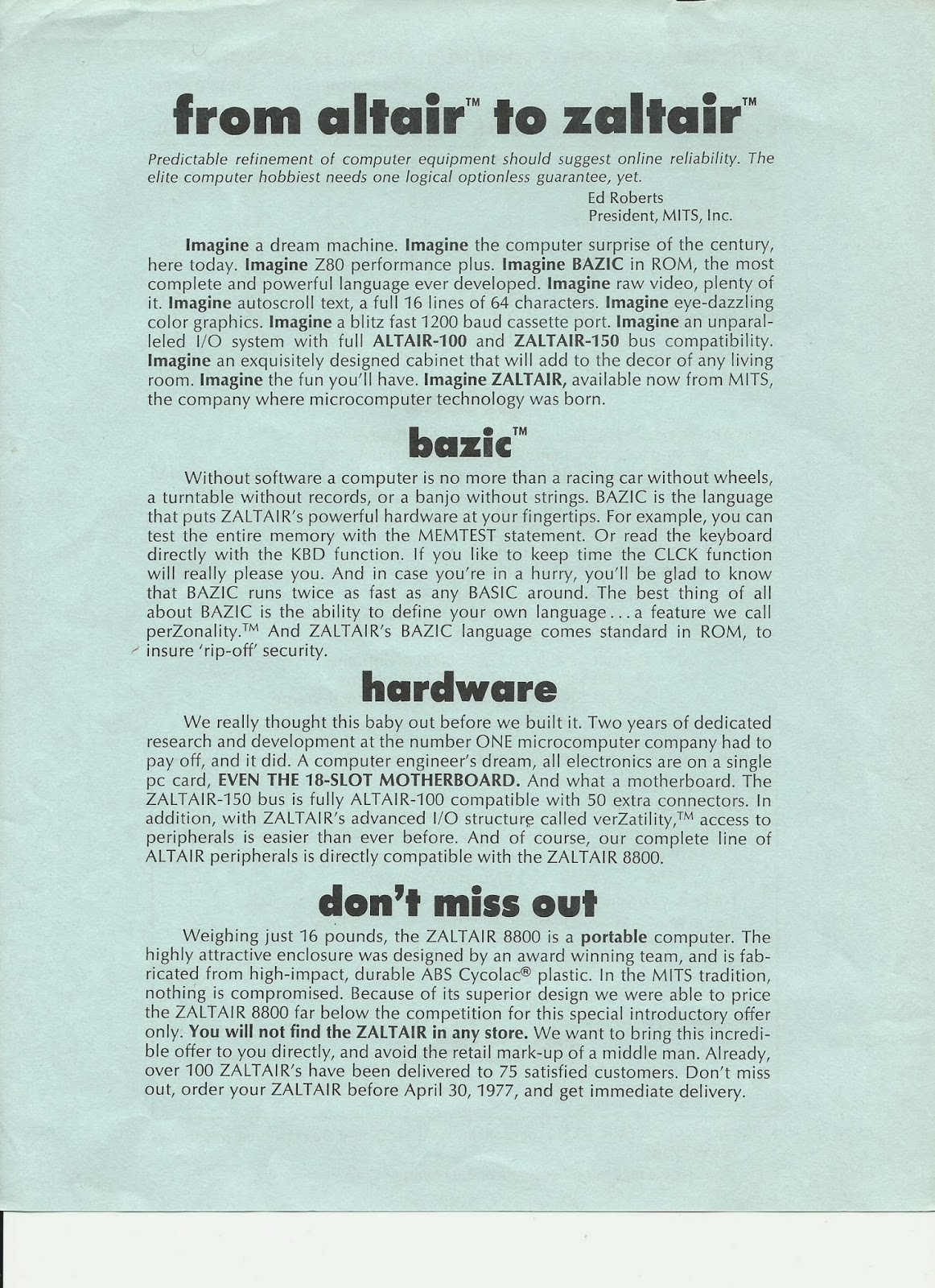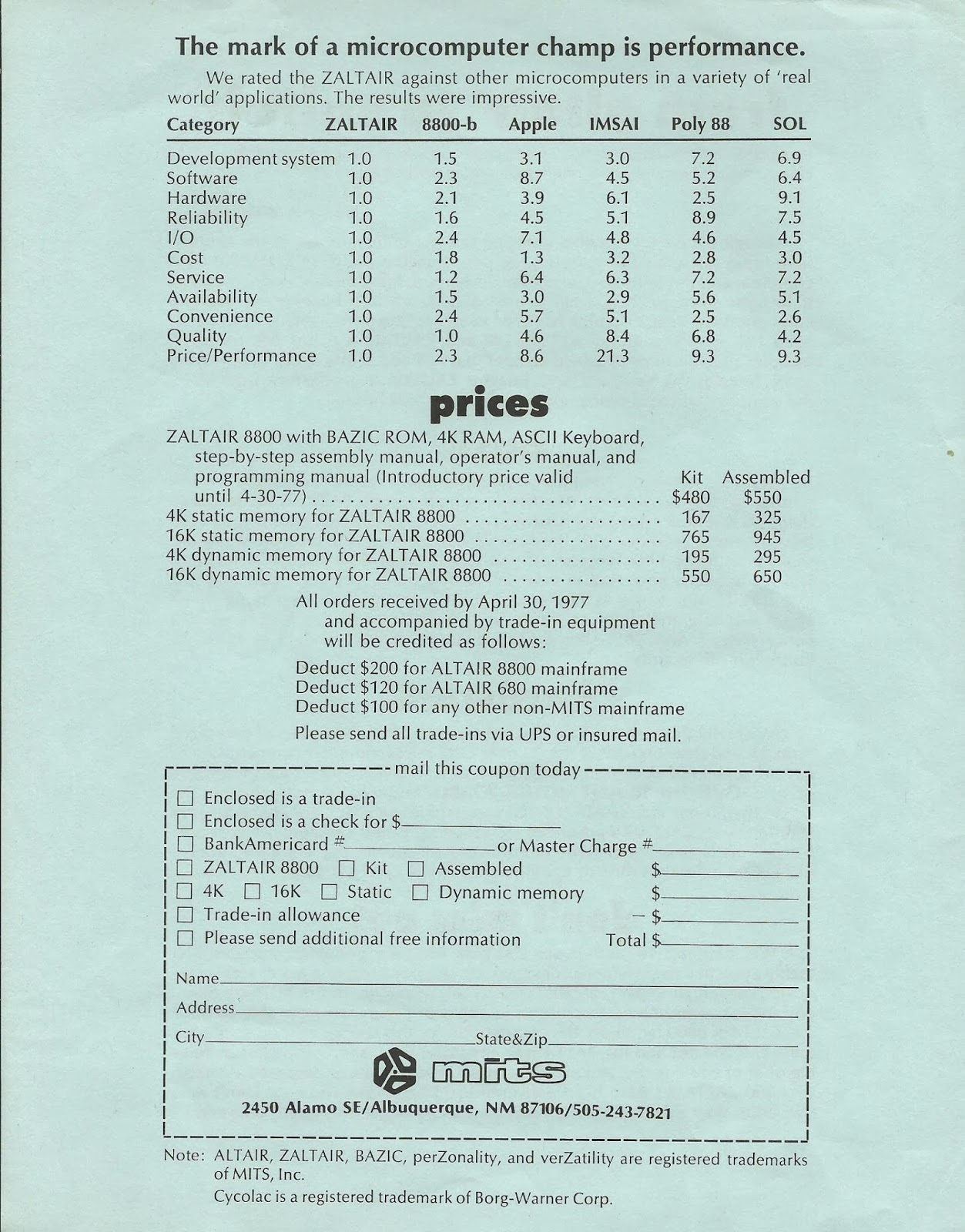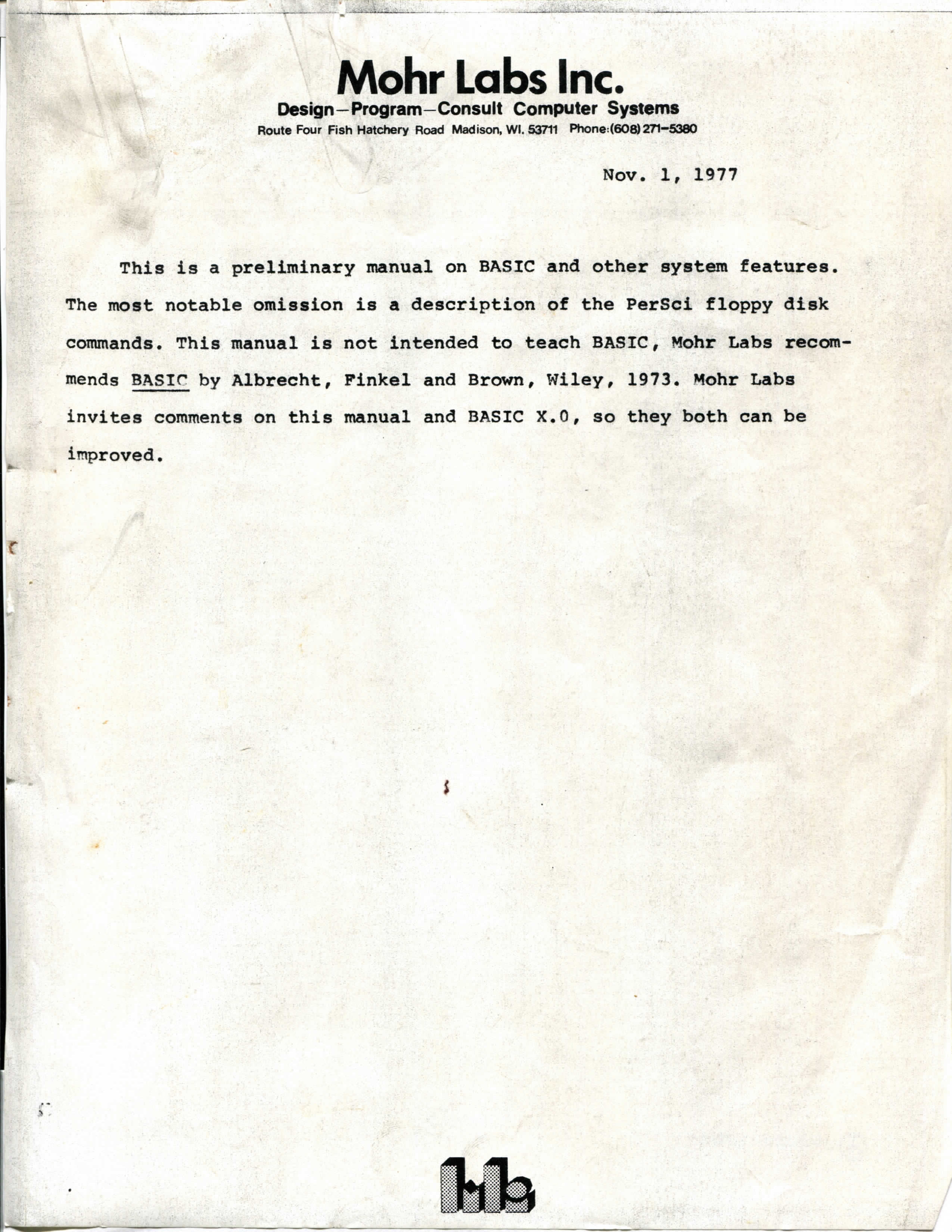 (ECD computer under the red lamp)
(ECD computer under the red lamp)In 1975, at the end of my senior year at MIT, I got a very unusual phone call in my dorm room in Bexley Hall. Prof. Jerome Lettvin, a very well-connected MIT professor, told me that if I could arrange a pickup, I could obtain a large piece of surplus equipment in a warehouse in Cambridge, Massachusetts. He told me it was one of six high-resolution, high-security "fax" machines designed to beam documents in and out of the Nixon White House. Somehow, the White House had made it a priority to get very detailed faxes. As I understood it, this top-secret project was contracted out to one of the many defense-related firms that spun off from MIT in the 1960s and 1970s. Were handwritten notes misunderstood? Was there a concern that ordinary faxes were being intercepted? Were any of these six machines ever finished or deployed? I do not have any idea.
I called my father, who lived about 8 miles away. I went home and talked him into driving his pickup truck (and me) to the warehouse. This enormous machine was taken to the basement of the apartment my parents had on the campus of Andover Newton Theological School in Newton Center. And there it sat. I was not about to tear it apart for parts. It was the size of a very large Xerox machine and was loaded with exotic parts. There it sat until I could work out a plan to get rid of it.
I did not graduate in the spring of 1975 with the rest of my class. I was getting a degree in Electrical Engineering, and I had failed to finish my senior thesis. A thesis was required for my major (if I wanted to graduate). My grades slumped between the end of my junior year and the beginning of my senior year. I wanted to write a stunning senior thesis to redeem myself. My thesis titled Does The Action Potential of the Nerve have a Mechanical Component? An Exploration of Models. I recently reviewed the medical/biological literature and found that the ideas I examined had been rediscovered and surpassed only a few years ago.
By this time, my fate was intertwined with Caryn Navy, the brilliant math student I hung out with and eventually married. After she had graduated, she went to graduate school in Madison, Wisconsin. So I moved to Madison as well. My fifth year at MIT was spent in Madison, making occasional trips back to Cambridge to further my thesis project.
In January 1976, I took an IAP (inter-session) course at MIT on the 6502 microprocessor chip. This was the same chip to be used on the Apple II computer. It was taught by a group of students that had made a great deal of money making high-tech scientific instruments (their most popular product measured capacitance). They were going to make a new fortune by manufacturing a breakthrough computer called the ECD MicroMind (often written with the Greek mu before the word "Mind"). Even though this was not part of my nerve cell project, I got terribly excited. They were talking about encoding vast amounts of information on laser disks (here we are talking about the 12-inch laser disks then used to record movies; the compact disk for music had not been invented yet). I imagined encyclopedias and vast numbers of periodicals available for the blind. I was hooked.
As a side note, it was a new idea that a group of brilliant undergraduate students would form their own technology company and then be rolling in money.
I managed to swap my high-tech super-secret "sorry we have to kill you because you saw it" Nixon White House communications terminal for an as yet not produced ECD MicroMind. They showed up at my parent's apartment and picked it up. I was on the list as if I had paid cash! Cool. I did not have to put up any money. Ned Prothro, my friend from Beirut, scraped together the $500 to get on the list. As it turned out, everyone who put up cash lost it. So I swapped my useless, white elephant junk machine for a slot for a doomed project.

Looking at early computer magazines from 1976, you might find a few full-page ads from ECD Corporation. I believe that a few wire-wrapped computers were produced and sold to institutions with the hope of interesting them in large-scale purchases. Being a poorly financed company, ECD went under without producing a commercial product. So, naturally, I did not get anything out of them. But by then, I had memorized every detail of every addressing mode of the 6502 chip. I knew the pipeline system. I knew all the commands. I was ready to write code. I just needed a computer.
 (ECD computer under the red lamp)
(ECD computer under the red lamp)
At the time, I did not understand that I had another link to the 6502 chip. My friend from MIT (his room was across the hall in Bexley), Alan Baum, was famous as the guy who helped finance his California buddies Stephen Jobs and Steve Wozniak so they could make their first computer called the Apple 1. I remember him telling me about Apple computers a few times. But I just ignored him. The famous loan from Alan Baum (actually Alan's father) of $5,000 to Steve Jobs and Steve Wozniak came three months after the IAP class on the 6502 chip.
Back in Madison, I was excited about microcomputers and their potential. I shared my interest with a math department groupie called Herman Berg. Herman Berg was a very odd character. He was brilliant. Sometimes he was normal; sometimes he was quite unbalanced mentally. He seemed to hang around math departments in various places. He came from Detroit. His father was blind. He was drawn to strange characters. I suppose Caryn and I stood out. Herman Berg was a strange guy. I could write a chapter about him. But I do not have to; someone else has. Check out the 1999 book Ethics and the University by Michael Davis. The chapter Of Baggage and Kings is about Herman Berg.
Herman Berg arranged for me to participate in a seminal moment in computer history. Through him, I was part of a group of eight guys who drove a van from Madison to San Francisco to get to the first West Coast Computer Faire on April 15-17, 1977. This was the event that introduced the Apple II computer to the public. I only paid attention to the Apple II because I was amused at how they struggled to project a visible image on a screen in the well-lit hall. They had brought an Advent VideoBeam projection TV which produced a washed-out image until Apple installed a tent in their booth to enclose the Apple and the projection TV. Seeing the line for people to enter a tent to view this wonder computer was hilarious. I did not realize this was "hour zero" for Apple Computer. I also remember the flyers for the "Zaltair Computer" which were distributed on all the tables. This was a famous prank that Steve Wozniak played on Steve Jobs.



Back in Madison, Herman Berg and I learned of a microcomputer club that met in the facilities of the Durant Manufacturing Company in Watertown, Wisconsin. The company made electronic switching and counting equipment. The management must have realized that the future lay in microcomputers. So they organized a computer club on their premises and opened it up to anyone. The idea was that one way or another, some of their staff would learn about microcomputers by seeing the enthusiasm of nerds invited monthly from around Wisconsin.
Watertown was quite a distance away from Madison. Fortunately, Herman Berg had a car. The meetings were at night in a large auditorium on the company grounds. At one of the meetings, Stephen Mohr gave a presentation about his company and his projects. Stephen had a company just south of Madison in the community of Fitchburg. He was making his own computer that could manage biological experiments for laboratories. And, miracles of miracles, it was based on the 6502 microcomputer chip.
I got his business card and applied for a job. I started work at Mohr Labs in August of 1976, about half a year since I took the IAP course on the 6502 chip at MIT. The office was a small business building along a busy road. On the other side of the road was a housing development. Surrounding the building was a cornfield. Welcome to Silicon Valley, Wisconsin version. A few months after being hired by Mohr Labs, my only article was published in the October 1977 Byte Magazine (about setting up a massive database with crude hardware).

Why choose the 6502 chip? In a word, it was cheap. They cost only $20 each when other microcomputer chips were much more expensive. Steve Wozniak was clear that the low cost drove him to use the 6502 chip. Ron Spinella of Bexley Hall obtained a 6502 chip. It was shown around to admiring electronics geeks. So it was unsurprising that ECD and Mohr Labs also focused on the 6502 chip.
Mohr Labs didn't mind hiring me because they had no money to pay anybody. My first project was to write a math package. I had to implement addition, subtraction, multiplication, division, trig functions, log functions, etc. I practically wrote in hex. The software was burned into 2708 EPROMs. Each chip held 1,024 bytes of data. You put the chips under intense ultraviolet light to erase their memory. Once, when I was working in our apartment, I realized that 2 bits had slipped from 0's to 1's. These were in a key routine, and it made progress impossible. So I bicycled 10 miles to the company, reprogrammed the defective chip, and bicycled back to my room. At the time, I imagined that this would make a world record for the amount of muscle effort expended compared to the microscopic change I was trying to accomplish (change 2 bits in an EPROM). I doubt my record still stands.
My salary was theoretical. I never got paid. I hung around and accepted their promises. If the labor and hour people heard about it, it would be jail time for everybody. In effect, I worked as an unpaid intern living off Caryn's traineeship money. I got very good at programming the 6502 chip, the main chip for the Apple II computer. But the tools I had were very, very crude. I could write assembly language, but without named addresses. I could not write 'jump to the print program.' Instead, I had to write, 'JMP to location FCA8.' I'd have to keep careful notes of each key location. Rearranging memory locations was a tremendous nightmare.
After I had finished the math package, they said to write a parser. When I finished the parser, they said to write all of BASIC. I like to brag that it was the world's worst implementation of BASIC, mainly because I had loaded it up with geeky math features. For example, it would calculate pi to 30 digits in about 20 seconds. But it could not do much else.
Here the narrative takes some twists and turns. I started the job at Mohr Labs in August of 1976. In January 1977, I married Caryn. In January 1979, I discovered that Mohr Labs was no more. I soon got a job at the Clinical Cancer Center at the University of Wisconsin. During my stay at the Clinical Cancer Center, I was supervised by the remarkable Stephen Entine.
As rewarding as this work was, it did not involve projects for the disabled. I took a job with Clinical Convenience in Madison (April 1980). During this time, I set up a database of commercial devices to aid the disabled. In the summer of 1980, I saw a one-page flyer for the VersaBraille paperless brailler. Things started to click. I bought an Apple II (with Caryn) in August. I started working on software for the Apple II that would interact with the VersaBraille. I spent $31 for the Lisa Assembler When I bought our Apple II computer. That software freed me from having to memorize memory locations. Lisa was used for almost all the Apple II software sold by Raised Dot Computing, probably bringing in about two million dollars over the years.
One thing I did was network with other people. I wrote letters to other groups to tell them my plans. I sent an early letter to the Veteran's Administration. Next, I sent a letter to Apple computer to negotiate to get copies of Apple documentation on floppy disks to process the text into braille. I knew that the software was useless unless users could read the documentation. Finally, I sent a letter to Telesensory (the maker of the VersaBraille) to obtain confidential technical information about how the serial interface worked.
These efforts did pay off. When I started collaborating with Harvey Lauer, he remembered my early letter. Apple did release their documentation to me. When I attended a computer conference in Chicago in the spring of 1981, I met Steve Jobs. I introduced myself, and he said, "You are the VersaBraille guy." Yes, Steve Jobs kept track of a lot of details. In January 1981, I traveled with my wife to San Francisco. I made a side trip to Telesensory, and they offered a fair amount of cooperation.
A few more twists and turns later, we moved to Lewisburg Pennsylvania, since Caryn had a job teaching at Bucknell University. I messed up several job interviews and started focusing full-time on the Apple/VersaBraille project. By early 1982, there was code to move text back and forth between the machines. I could translate from text into braille and from braille back to text. I offered this software for sale as BRAILLE-EDIT from Raised Dot Computing. I featured this software in my August 1981 entry to the first national search for Computer Applications for the Handicapped mounted by John Hopkins and the IIIE.
My ability to immediately get good results was due to several factors. One was that I had a model of a professional blind person in my own household. So I knew what was important and what was not. But a key factor was my immense background working on 6502 assembly language, which I can trace back to the course I took at MIT. Somehow, I had swapped a very heavy piece of donated machinery for a career writing braille translation software.